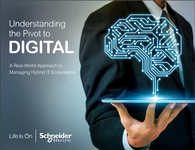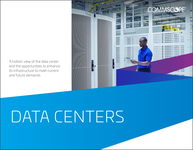The start of a new year has everyone set on paths of reinvention. Personal development is at the top of everyone’s agenda: veganism and gym memberships are all the rage, and many professionals are applying the same mindset to their careers. In the IT world, attention is turning to operations, and data centers in particular require a renewed focus, especially amid evolving trends.
The volume of data has grown so much it’s difficult to quantify - some estimate we process 2.5 quintillion bytes of data every day. This volume is only set to grow, and with it the risk of the data stagnating and losing its value.
In fact, the tech industry is just beginning to address the dangers of “data lakes” - huge pools of unstructured data housed “just in case.” In many cases, these are becoming expensive data swamps costing some industries up to £15 billion a year.
Exponential increases in data volumes aren’t the only issue IT pros face. With continued hype around the benefits of cloud migrations, many businesses are migrating their existing on-premises systems without considering the merits of having a hybrid cloud model in place.
At best, this means deployments are unlikely to be fit for purpose and will have IT teams questioning the return on their investment. At worst, these deployments may lack the necessary security measures because they weren’t accounted for from the outset.
For example, some businesses make the mistake of not testing backup systems, which means they have no way of knowing whether their backup systems will work when crisis strikes. If it can’t be restored, the data is as good as dead.
As we approach a new and increasingly data-driven decade, what data center tips should IT pros consider as they look to stay ahead of the curve?
Start prioritizing governance
Data governance includes the people, processes, and technologies needed to manage and protect a company’s data assets. Governance is necessary to guarantee understandable, trustworthy, and secure corporate data while simultaneously filtering out anything valueless.
Some people think more data means more value, but this simply isn’t true. Businesses naturally accumulate data they don’t need, adopting the bad habit of stockpiling it unnecessarily and complicating the process of deciphering what data is most valuable. These greater volumes of data create the need for greater and more complex governance, as each individual data point must be assessed for its sensitivity, storage requirements, and real business value. Dealing with redundant data also needs to be handled with care.
This problem has been addressed to an extent, but it continues to be overlooked simply because it doesn’t rank high enough on the list of business and IT priorities. The biggest data governance challenges can be easily managed with the right processes - including the introduction of automation - ultimately helping you regain control of your data.
Consider a hybrid cloud program
Following the advent of cloud technology, businesses have been quick to jump on the cloud bandwagon without properly evaluating their options. As a result, they’ve been stung by unforeseen costs. Over time, the technology has evolved, and businesses now have the option to adopt a hybrid cloud model potentially offering the best of both the on-premises and cloud worlds.
Here’s how it compares:
- Public: Your resources are hosted across one or several cloud providers. The largest providers of public cloud services include Microsoft Azure and Amazon Web Services (AWS).
- Private: You create your own private cloud using a platform like OpenStack or VMware vCloud.
- Hybrid: Your resources are hosted across a mixture of on-premises, private cloud, and third-party public cloud services with connections you can monitor.
Though the public cloud has captured headlines in recent years, many enterprises are now being drawn back to on-premises software solutions, as these are usually more cost-effective. According to IBM, 98 percent of companies will embrace a hybrid cloud model by 2021. Providing a healthy mix of reliability, security, and reduced operations costs, hybrid cloud options can be attractive for IT pros looking to scale their operations and streamline functionality while maintaining control.
Regularly test your backup and recovery
Having a backup system and knowing it works are entirely different things. With so much at stake, IT pros should put greater emphasis on backup and recovery testing in 2020 and beyond. Since it can be easily solved and because it’s in the backdrop of constant threats to data security, IT pros should test their backup systems— whether they operate in a cloud or on-premises system.
Too many IT pros have had their fingers burned after realizing their backup system failed, their backup system ran out of space, or they didn’t have a backup system in place at all. Testing is critical in highlighting backup system issues where data won’t be restored after a failure. It’s far better to uncover a problem during a dress rehearsal than it is during the real thing. Being confident your data can be restored is priceless.
Keep a close eye on efficiencies
We don’t want to bash the public cloud; in some cases, it’s the ideal solution. However, you should know where your cloud dollars are being spent.
The main reason businesses move to the cloud is to save money. The origins of AWS lay in Amazon’s pursuit of extreme cost savings, and this move has outstripped its other offerings in contributing to the company’s overall income. The lesson here is, if you’re not continuing to check for cost savings in this area, what was the point of it all? Those who have migrated their businesses to the cloud may find unexpected costs racking up. If this goes ignored and unmonitored, your bill could increase three times over without you realizing.
The first thing you should do is understand how the cloud business model works. Nearly all cloud offerings sell on an operating expense model, which acts as a monthly subscription service in which you pay for what you use. This is great if you’re looking to reduce the costs of a large on-premises system with a huge quantity of unused space. However, you can end up accidentally incurring additional costs if you don’t have full visibility into the system.
Stay committed
Whether it’s on-premises or in the cloud, IT pros need to ensure they have complete visibility into their data center. If anything goes wrong, a monitoring system capable of identifying the issues will enable you to address them head on.
Effective data center monitoring can be applied to each element of the data center, including backup and discovery testing, how your data is organized, and the efficient allocation of data center resources. In achieving full visibility through monitoring, you already begin addressing governance by identifying and separating useful and redundant data. In turn, this helps reduce your looming cloud bill by cutting down on resources wasted on storing unnecessary data.
Implementing new changes to manage your data center - and sticking to them - is a great way to start habitually improving issues otherwise swept under the rug. Because data centers are ever changing and face constant threats, it’s important for IT pros to identify areas for improvement and stay committed to their goals. This will mark the beginning of a new era, a new focus for the department, and a new data center.





